

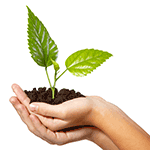 Happy New Year!
Happy New Year!
With the New Year comes a new set of resolutions to make either our lives or the lives of those around us better. At Norwex, our resolution is to continue creating a better quality of life for everyone, and what better time than now to help you start the New Year with a healthier home. Now is the time to check your house for common toxic chemicals and choose safer alternatives for less toxic living.
We may assume they are safe, but in fact, many household cleaners are dangerously toxic. No one can avoid exposure to toxic chemicals altogether, but it is possible to reduce it significantly. The good news is that these toxic chemicals can be replaced with safer, more natural options that really work. Below are some of the worst offenders commonly found in household cleaning products, and ways to swap them for healthier, safer options.
Phthalates
Phthalates are found in many fragranced household products, such as air fresheners, dish soap, even toilet paper. Because of proprietary laws, companies don’t have to disclose what’s in their scents, so you won’t find phthalates on a label. If you see the word “fragrance” on a label, there’s a good chance phthalates are present. Phthalates are known endocrine disruptors. Although exposure to phthalates mainly occurs through inhalation, it can also happen through skin contact with scented soaps. Unlike the digestive system, the skin has no safeguards against toxins. Absorbed chemicals go straight to organs.
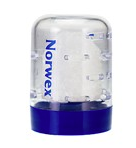
The healthier choice is to choose fragrance-free or all-natural organic products. Use essential oils or simply open windows to freshen the air. Also consider adding more plants to your home: they’re natural air detoxifiers. Consider Norwex products like Fridge So Fresh, Sportzyme and Odour Eliminator to eliminate sources of odor.
Perchloroethylene or “PERC”
Found in dry-cleaning solutions, spot removers, and carpet and upholstery cleaners, PERC is a neurotoxin and possible carcinogen. The route of exposure is most often inhalation, that telltale smell on clothes when they return from the dry cleaner, or the fumes that linger after cleaning carpets. A healthier choice is to take curtains, drapes and clothes that are labeled “dry clean only” to a wet cleaner, which uses water-based technology rather than chemical solvents. The EPA recently recognized liquid carbon dioxide (CO2) as an environmentally preferable alternative to more toxic dry-cleaning solvents. Ask your dry cleaner which method they use.
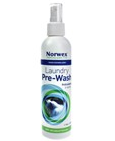
The Healthier Choice: For a safer spot remover, use Norwex Laundry Pre-Wash. It’s 100% natural, biodegradable, non-toxic—and it works!
Triclosan
Found in most liquid dishwashing detergents and hand soaps labeled “antibacterial,” triclosan is an aggressive antibacterial agent that can promote the growth of drug-resistant bacteria. The healthier choice is to use simple detergents and soaps with short ingredient lists, and avoid antibacterial products with triclosan for home use.
The Healthier Choice: Use Norwex Timeless Natural Hand Cleaner with organic Rosemary, Lavender and Lemon to naturally clean hands. It’s triclosan- and alcohol-free, non-toxic and won’t dry your skin like alcohol-based hand cleaners.
Quaternary Ammonium Compounds or “QUATS”
Found in fabric softener liquids and sheets, as well as most household cleaners labeled “antibacterial,” QUATS are another type of antimicrobial, and thus pose the same problem as triclosan by helping breed antibiotic-resistant bacteria. QUATS was found to be one of the leading causes of contact dermatitis and is also suspected as a culprit for respiratory disorders.
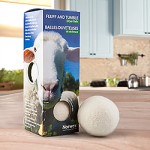 The healthier choice for your laundry is to use the Norwex Fluff and Tumble Dryer Balls. They reduce static cling without chemical-laden dryer sheets or fabric softeners. Made of 100% New Zealand wool, our Fluff and Tumble Dryer Balls soften fabric; reduce static and cut drying time by up to 25%. They carry a two-year warranty.
The healthier choice for your laundry is to use the Norwex Fluff and Tumble Dryer Balls. They reduce static cling without chemical-laden dryer sheets or fabric softeners. Made of 100% New Zealand wool, our Fluff and Tumble Dryer Balls soften fabric; reduce static and cut drying time by up to 25%. They carry a two-year warranty.
2-Butoxyethanol
Found in window, kitchen and multipurpose cleaners, 2-butoxyethanol is the key ingredient in many window cleaners and gives them their characteristic sweet smell. It belongs in the category of “glycol ethers,” a set of powerful solvents that don’t mess around. Federal laws do not require 2-butoxyethanol to be listed on a product’s label. According to the EPA’s website, in addition to causing sore throats when inhaled, at high levels glycol ethers can also contribute to narcosis, pulmonary edema, and severe liver and kidney damage. The EPA sets standards on 2-butoxyethanol in the workplace for safety, but the Environmental Working Group warns that if you’re cleaning at home in a confined area, like an unventilated bathroom, you can actually end up getting 2-butoxyethanol in the air at levels that are higher than workplace safety standards allow.
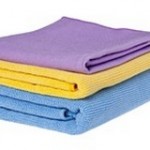
The healthier choice is to clean windows and mirrors using only water and a Norwex Enviro Cloth or Window Cloth. Not only will you reduce chemicals in your home, because there is no chemical residue to attract more dirt, surfaces stay cleaner, longer.
Ammonia
Found in polishing agents for bathroom fixtures, sinks and jewelry as well as in glass cleaner, ammonia is a powerful irritant that can affect people with asthma and elderly people with lung issues and breathing problems. People who get a lot of ammonia exposure, like housekeepers, often develop chronic bronchitis and asthma.
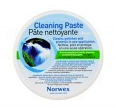
The healthier choice is Norwex Cleaning Paste for polishing and protecting chrome, stainless steel, aluminum, porcelain and similar surfaces. Acid- and phosphate-free it also works great on bathroom tubs and tile.
Sodium Hydroxide
Found in oven cleaners and drain openers, sodium hydroxide is extremely corrosive. If it touches your skin or gets in your eyes, it can cause severe burns. Routes of exposure are skin contact and inhalation. Inhaling sodium hydroxide can cause a sore throat that lasts for days.
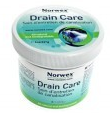 The healthier choices are Norwex Oven & Grill Cleaner and Drain Care products. Norwex Drain Care helps dissolve clogs and eliminate slow drains and odors, and is gentle on pipes and safe for the environment. Free of poisons, acids, solvents and other caustic ingredients, Drain Care is safe for all plastic and metal pipes. Norwex Oven & Grill Cleaner safely dissolves baked-on, burnt-on food and stubborn, greasy spills for easy clean-up without caustic chemicals or fumes. It is highly effective, environmentally friendly, all-natural and biodegradable.
The healthier choices are Norwex Oven & Grill Cleaner and Drain Care products. Norwex Drain Care helps dissolve clogs and eliminate slow drains and odors, and is gentle on pipes and safe for the environment. Free of poisons, acids, solvents and other caustic ingredients, Drain Care is safe for all plastic and metal pipes. Norwex Oven & Grill Cleaner safely dissolves baked-on, burnt-on food and stubborn, greasy spills for easy clean-up without caustic chemicals or fumes. It is highly effective, environmentally friendly, all-natural and biodegradable.
Whether or not you choose to use Norwex products, our desire if for everyone to be aware of the potential problems associated with some of the chemicals found in common household cleaners. The more we are all aware, the healthier we can all be.
References:
https://experiencelife.com/article/8-hidden-toxins-whats-lurking-in-your-cleaning-products/
I love my NORWEX chemical free products. This is something I can be passionate about and share with others so that they can make a difference in peoples lives also. It is a huge blessing.
Fridge So Fresh?! I keep hearing names of products I want to try!!